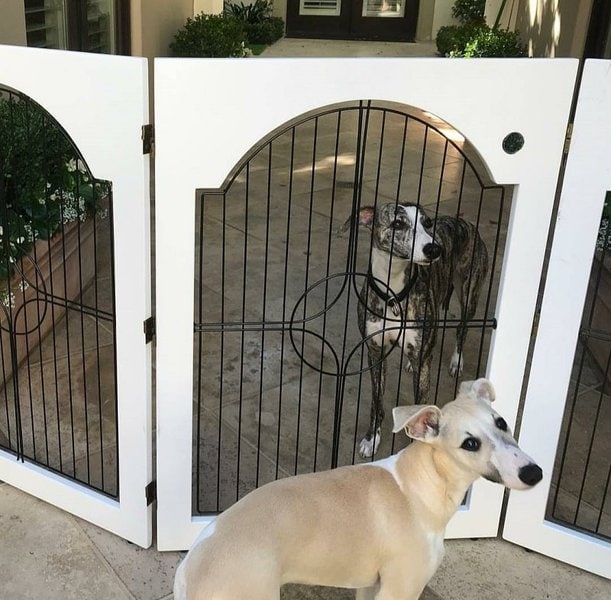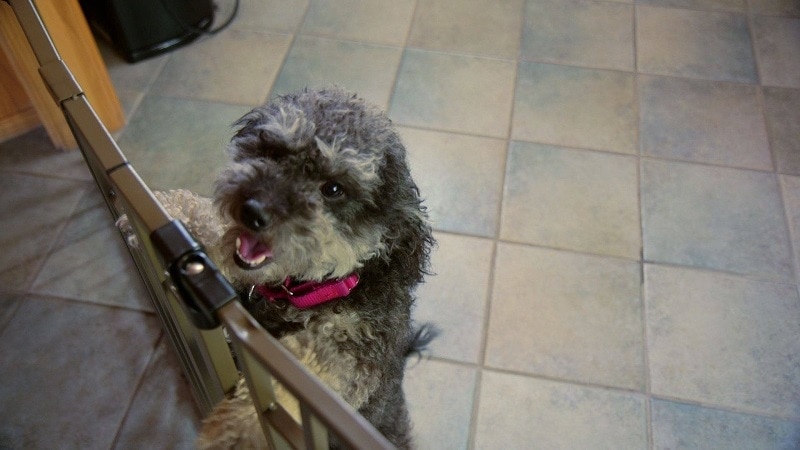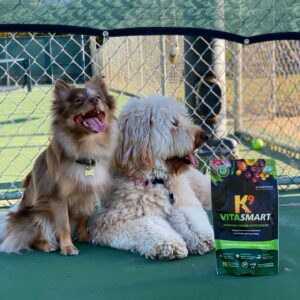The best indoor dog gate is the Richell 3-In-1 Convertible Elite Pet Gate.
Man’s best friend is an adventurous creature that would love to go to just anywhere. Especially for untrained dogs, you would prefer them to be kept restricted off an area in your house where they won’t damage stuff. It’s for their security and safety.
The best way to do so is by getting an indoor dog gate to keep them safe.
Indoor dog gates are an important addition to any home with a dog. They provide an easy way to contain your dog, keep your pet out of trouble, and protect your home from damage.
We have compiled a list of the best indoor dog gates, so let’s explore them in detail!
#1 Richell 3-In-1 Convertible Elite Pet Gate
Looking for an indoor canine gate that has three different functionalities in one?
Search no more! The Richell 3-in-1 convertible elite pet gate is your ultimate choice for an indoor dog gate to cater to all your needs. With just six panels, it does not only operate as a freestanding gate but also as a pet pen and a room divider.
The gate is constructed from brown hardwood, which would undoubtedly add beauty and taste to any home décor.
While using it as a freestanding indoor dog gate, it comfortably covers spaces spanning 129.9 inches to 134.4 inches wide.
With all that extra length, this makes this product the best indoor dog gate there is out there. It’s highly versatile, and you can use it for apartments and big houses.
The indoor dog gates from Richell are very easy to assemble and configure into the different modes. It can also be easily folded for storage after removing the caps. The sustainable rubber and hardwood used in manufacturing are durable, saving you money in repairs.
Pros
- Richell’s convertible pet gate comes with a lockable gate door that makes it possible for customers to provide their pooches with access to different rooms without having to move the entire gate.
- The multifunctional design of this 3-in-1 product from the Richell brand makes it suitable for use either as a freestanding dog gate, a room divider or a crate for pooches.
- Assembly and installation of this indoor canine gate is considerably straightforward, and when required, customers can conveniently move the product for use at various locations in the home.
- This indoor dog gate product from the Richell brand features specially designed caps that lock the gate’s panels securely in place at either 90° or 180° to provide extra stability.
- The Richell convertible pet gate features a beautiful hardwood construction that doesn’t look out of place among home furniture and contributes to the improvement of home aesthetics.
Cons
- Several customers have commented that the lock that comes with this pet gate product can be easily worked on and opened by a pooch.
- There have been several reports about this indoor dog gate lacking stability and being easily tilted when pushed against by a pooch.
This product is our top pick because of its functional versatility as a gate or a pen that its extra length has provided; plus, its aesthetic hardwood frame finish means it would not be an eyesore and can fit nicely in any home decor.
#2 Internet’s Best Traditional Pet Gate
With a classic look to match your home décor, the Internet’s Best Traditional Pet Gate is a very impressive indoor dog gate to keep your pooch safe. It is also a great option for budget-conscious folks to consider.
Setting it up in a “Z” formation, this gate can be used almost anywhere within the house, such as stairs, hallways, and bedrooms. It is constructed from wood and weighs 28.9 lbs. It is also available in two colors; Espresso and White.
When fully assembled, it covers an extra-wide length of 80 inches. This indoor dog gate has a height of 30 inches high, which makes it difficult for small or medium-sized dogs to jump over.
This dog gate from Internet’s Best exhibits a simple design that is bound to capture the attention of minimalists. It can also be folded for storage in smaller spaces. Its color options, Espresso or White, should help blend in with almost every home décor.
Pros
- This traditional pet gate product from Internet’s Best features hinges between each panel, giving it the versatility for customers to modify the product for use in hallways, doorways, hallways, at the bottom of staircases and in the bedroom.
- This indoor dog gate comes in 3-panel and 4-panel styles, as well as 24” and 34” height options, to enable customers to make purchases based on the gate’s intended use and their pooches’ characteristics.
- Customers can fold this traditional pet gate down to a height of just 3” for convenient storage in narrow spaces when the product isn’t needed.
- This indoor dog gate comes with a free-standing design, and it doesn’t need to be screwed or attached to a wall before it can be used for the intended purpose.
- Internet’s Best traditional indoor dog gate typically features a classic white or rich espresso finish that, in most cases, complements existing home décor.
Cons
- This traditional pet gate product isn’t very sturdy, and it tends to break when knocked over on hardwood floors or similarly hard floor surfaces.
- There are doubts about the durability of this indoor dog gate, as several customers have reported that the product’s hinges usually become loose after just a short period of use.
#3 PETMAKER Wooden Pet Gate
Hailing from PETMAKER, this is your ideal indoor dog gate to keep your fluffy friend away from accessing some parts of your home. Its length is suitable for almost any place you would wish to keep the gate.
Setting up in a “Z” formation, it can be used for wide hallways, wide double doors, etc. Weighing at 4.75 lbs, the high-quality yet lightweight wood is strong enough to prevent toppling in case your canine companion tries to knock it down.
When fully opened, it can cover up to 54 inches wide, but this will require something to hold the gate upright.
This indoor dog gate from PETMAKER is heavy enough to withstand your dog and yet light enough to easily carry, fold and store. Its storage is the best as it folds down to 3 inches, meaning you can even keep it in your closet.
Pros
- The lightweight design of PETMAKER’s wooden dog gate product ensures that it can be easily moved around the home for use in restricting access to certain areas or confining a pooch to a particular room.
- This PETMAKER indoor dog gate comes ready to use and can stand on its own without customers needing to drill holes to screw and attach the gate to a wall.
- Customers can fold down this wooden pet gate for convenient storage in small spaces whenever the product isn’t in use.
- This indoor wooden dog gate features a neutral brown finish and decorative arch design that ensures that the product doesn’t stand out oddly among existing home furniture and décor.
- The spacing between the frames of the PETMAKER indoor gate allows free passage of light and air and also makes it possible for customers to keep an eye on their pooches on the other side of the gate.
Cons
- The lightweight design of this indoor dog gate makes it relatively easy for medium to large-sized pooches to nudge and move the gate out of the way.
- Some customers have reportedly received PETMAKER gates with sharp and dangerous splinters sticking out of the gates’ frames.
#4 PAWLAND Wooden Freestanding Foldable Pet Gate For Dogs
Made from tough wood and durable metal hinges, you are sure of owning a long-lasting dog gate that won’t give you any issues in the near future.
This PAWLAND pet gate uses an accordion-like hinge design, thereby allowing you to install this indoor dog gate at nearly any location within the house, such as the staircase, kitchen, or hallways.
This indoor dog gate is perfect for blocking any wide entrances, as it has an extra-wide length of 80 inches when fully assembled.
The PAWLAND pet gate can be used as a fence, room divider, or pet pen. Its stylish and elegant looks are ideal for any homestead without affecting your home décor. Besides the added stability, the sturdy non-slip rubber feet are very useful in preventing scratches to the floorboards, unlike with some other gates.
Pros
- The freestanding design of this pre-assembled PAWLAND indoor dog gate ensures that it can be used to restrict canine movement without needing to drill holes in walls or use other attachments.
- This indoor dog gate product can be conveniently folded down into a considerably smaller size that makes it possible for customers to put away the product when not in use without taking up much space.
- This PAWLAND indoor dog gate comes with non-slip rubber feet that provide the product with a firmer grip on smooth floors, thereby preventing the gate from constantly sliding out of place.
- PAWLAND’s freestanding pet gate for dogs features a well-thought-out design with versatility to be conveniently used either as a dog fence, room divider, or a pen to contain a pooch.
- Customers can collapse and configure this freestanding foldable gate to fit most doorways and hallways and serve as a barrier to dog movement within the home.
Cons
- The lightweight design of this PAWLAND product makes it considerably easy for pooches to push the gate over and gain access to restricted areas.
- This indoor dog gate isn’t very sturdy, and it is constructed with soft wood material that breaks easily whenever the product falls over.
#5 Primetime Petz 360 Configurable Dog Gate With Door
If you have a playful dog who chews almost anything, here is your solution. Hailing from Primetime Petz, this 360° configurable dog gate with a door is made from chew-resistant solid wood, thereby keeping your pooch away from restricted parts of the house.
The gate comprises four panels, weighing 17.39 lbs and spanning up to 72 inches wide. It also comes with a smaller pet gate to allow your pet dogs to pass through without collapsing the entire gate.
Featuring the 360° hinge design, you can configure your furry four-legged friend’s play space in a couple of ways.
This product also comes with rich Walnut or White finish options to fit your home décor. Its elegant and classy finish will add more exquisiteness to your home.
The four wide panels can span up to 72 inches making the gate suitable for dogs of any breed and size. The 360° hinges allow the doors to be opened both inwards and outwards, making them fit almost anywhere with your preferred configuration.
Pros
- Primetime’s configurable dog gate comes with hinges that rotate all the way through to provide customers with various ways of configuring the gate for use in the home.
- The Petz 360 canine gate features a walkthrough door, which locks securely in place with a spring-loaded bolt that customers can use to grant their pooches controlled access to various sections of the home.
- The rubber pads located at the base of this indoor dog gate protect fine floor finishing from being scratched by the product, in addition to improving stability and preventing the gate from unnecessarily sliding around.
- The 360° hinges of the Petz 360 dog gate make it easy for customers to fold the product. and when combined with a lightweight design, the gate can be conveniently transported for use across the home and put away when it isn’t needed.
- Owners of the Petz 360 dog gate have the option to customize the product with additional wall-mount kits for extra stability and extension kits to create extra-wide openings.
Cons
- The door latch that comes with this indoor dog gate is loose, and it tends to come undone whenever the gate is moved.
- There are doubts over the quality of this product’s construction, as several customers have reported various components of the gate falling apart after just a short period of use.
#6 Carlson Extra-Wide Walk-Through Pet Gate
This all-steel indoor canine gate from Carlson is the perfect answer for those with both big and small dogs. Its chew-resistant material saves you more money on repairs.
This white-colored gate can be easily installed using the pressure-mount system or by using the wall mount brackets. It also has a small walk-through 8-inch by 8-inch door that operates using an easy touch release handle, allowing your dog to pass through when you need it to.
As compared to the first few indoor dog gates, this product is more suited for smaller apartments as it only expands to between 29 inches to 36.5 inches wide. It is also 30 inches tall, making it ideal for keeping larger dogs in.
This Carlson dog gate has a state-of-the-art design that adds taste to your home décor. Its installation and removal process is very easy. Its use can be expanded to hallways and spaces spanning a width between 29 inches to 37 inches.
Pros
- Carlson’s walkthrough dog gate features an all-steel and rust-resistant construction that enhances the product’s durability and provides a long period of use.
- This indoor dog gate product incorporates a pressure mount design that attaches to walls to provide increased stability and make the gate more difficult for pooches to knock over.
- This extra-wide dog gate features a patented small dog design, which ensures that small pooches can safely pass through while still restricting access for larger pooches that may be behind the barrier.
- The Carlson indoor dog gate fits openings that range in width from 29” to 36.5”, and customers can also purchase the 4” wide extension kit to make the product cover even more space.
- The lever-style handle of this walk-through dog gate features a one-touch release safety lock that customers can conveniently use to open and close the gate’s door.
Cons
- The spaces between this gate’s frame are wide enough for pooches to stick their heads through and potentially choke themselves.
- The walkthrough door of this indoor dog gate is considerably narrow, thereby making it difficult for people carrying items to pass without bumping into the sides of the door.
#7 Carlson Home Design Extra Wide Walk-Thru Pet Gate
This unique pet gate from Carlson covers openings between 29 inches to 42 inches wide, a width sufficient to cover most homes’ doorways.
Its design can be used for wide hallways or even double-sized doors, using the 4-inch or 6-inch extension kits provided. Without the extensions, it can be folded flat for easy storage.
This gate also stands at 30 inches tall, a height that would certainly deter most pets from jumping over it. Made of cast iron that is painted black, it is built for durability and chew resistance.
Besides its regular door, this product comes with the patented small pet door, measuring 10 inches tall by 7 inches wide, allowing smaller dogs to go through with ease. As such, this indoor dog gate can be configured to allow small pets out of the enclosed area while keeping bigger pets contained.
This indoor doggie gate from Carlson is ideal for almost any space, regardless of how wide or sophisticated the structure is. Its height will keep most dog breeds from passing through. The sturdy cast-iron material used is chew-proof and cannot be knocked down by heavy or aggressive dogs when its edges are properly secured to the wall.
Pros
- The Carlson indoor gate stands 30” tall and can be expanded to block openings with widths ranging from between 29” to 42”, thereby providing an effective means of restricting canine access to certain areas.
- Customers can purchase and install additional 4” or 6” extension kits to increase the width of the space that can be cordoned off with the Carlson indoor gate.
- Carlson’s home design indoor gate features a small pet door, which comes with a locking feature, that is intended to let small pooches pass through whilst still keeping larger dogs on the other side.
- Customers can fold this indoor gate flat for convenient and space-saving storage whenever the product isn’t in use.
- The easy-close handle that comes with this indoor gate’s door also features a one-touch release safety lock that customers can use to either open or close the gate’s walkthrough door.
Cons
- The main gateway opening of this indoor gate is considerably narrow and can prove difficult to be difficult for people to comfortably pass through.
- Some customers have remarked that their medium-sized pooches were able to easily walk through the small pet door included in this indoor gate, thereby defeating the product’s purpose.
#8 Arf Pets Free-Standing Wood Dog Gate
If you wish to own an indoor canine gate that you can temporarily place somewhere or keep at different locations from time to time, then this is your ultimate choice. The freestanding dog gate from Arf Pets can also be folded to create a pet pen.
This indoor doggie gate is very light, allowing you to carry it around without any constraints, but heavy enough to keep the dog from taking it down. The elegant dark wood finish does not disturb your home’s image but adds more value.
When fully expanded, the freestanding dog gate covers a generous 80 inches in length. This product stands at the height of 31.5 inches, much taller when compared to the other options here.
This four-panel foldable gate from Arf Pets has a smaller door for dogs to pass through easily. The gate can also be easily folded to create a dog pen. It also allows for one to expand the size of the gate further by another 40 inches with the purchase of its two-panel extension.
Pros
- When fully extended, Arf Pets’ wood dog gate stands up to 31.5” high and covers a width spanning up to 80”, thereby making it suitable and effective for use with most doorways and hallways.
- This freestanding dog gate product comes with a hinged door that customers can latch for security and unlatch for pooches and humans to pass through the gate freely.
- The interconnecting panels – with flexible hinges – of this indoor dog gate from Arf Pets can be modified and configured into a crate enclosure to keep pooches contained.
- Its stabilizing support feet help to keep the wood dog gate securely in place and prevent it from toppling over needlessly.
- The Arf Pets wood dog gate features a rich espresso finish that is designed and intended to blend in seamlessly with existing home décor and furniture.
Cons
- The reversible design of this indoor dog gate’s hinges, combined with its lightweight production, makes it easy for medium to large-sized pooches to simply push the product out of the way and pass through.
- The bottom part of this gate’s latch tends not to lock properly, and there have been several reports of dogs pushing the gate’s door open simply by straining against the bottom part.
#9 SPIRICH Dog Gate With Door Walk-Through
The SPIRICH dog gate with a walk-through door comes extra wide at 96 inches and 30 inches tall, making it perfect for tall dogs. If you have a pup that you need to contain or a large dog, this dog gate will be a perfect choice.
This product has a solid wood frame plus a strong mental wire interior. It has four panels that are well secured and connected with 360° hinges.
It can also be used in doorways, hallways, or any wide spaces in your home. The lockable door lets you move around freely without dismantling the gate.
This dog gate is portable and has two protruding support feet for added stability against toppling. Hence, its freestanding design does not need any wall attachments to function.
We love the extra-wide design that the SPIRICH dog gate employs. It is durable, thanks to its metal and wood design. You don’t need any wall fixtures because it is freestanding. We love its walk-through design because you don’t have to dismantle it while trying to get through.
Pros
- The pre-assembled and free-standing design of this product ensures that customers can set up the dog gate for use without having to use wall attachments and drill screw holes in the house’s walls.
- SPIRICH’s indoor dog gate comes with two support feet that are designed to enhance the product’s sturdiness and prevent it from toppling over under the slightest touch.
- Its 360° hinges make it possible for customers to configure it in a variety of ways, including as a dog gate to restrict canine access to doorways and hallways.
- The SPIRICH walk-through gate can be collapsed and folded for storage in small spaces when not in use, thereby making it ideal for homes with limited storage space.
- The metal wire slats of the SPIRICH indoor gate are spaced wide enough to prevent a pooch from squeezing through; at the same time, they provide enough visibility to reassure dogs that they aren’t being punished or cut off from the family.
Cons
- Several customers have left feedback about the pre-drilled holes on this indoor dog gate not lining up correctly, thereby making it difficult to properly latch the walk-through door.
- The two support feet that come with this product are, in most cases, not sufficient to keep the gate from falling over when pushed by a pooch.
#10 Summer Infant Walk-Thru Baby Gate
When you wish to combine simplicity and convenience in one statement, think of the Summer Infant Walk-Thru Baby Gate.
Despite being rated for babies, its all-metallic, pressure-mounted gate works well with pups and adult dogs too. Its three finish options, namely Black, Beige, and Bronze, will surely fit any home décor.
The product has a width spanning 28.5 inches to 48 inches wide and a height reaching up to 36 inches tall. Such dimensions are ideal for protecting even the larger dogs from accessing the restricted parts of the house.
Another really neat feature is that this indoor dog gate comes with an expandable option. You can configure it to fit any openings between 28 inches to 48 inches wide.
The door auto-close feature of this Summer Infant gate lets the door shut gently behind you instead of banging it, thereby reducing wear and tear. The pressure mounts are padded and do not leave any marks on your wall. The option of hardware mounting is also available to make it more secure.
Pros
- This 36”-tall indoor dog gate expands to fit openings that are between 28.5” to 48” wide and can be adapted for use in doorways and stairways around the home.
- Customers can either choose to pressure-mount the Summer Walk-Thru gate or use tools to carry out the more stable hardware mounting.
- The auto-close design of this product’s walkthrough door gently closes the door behind people passing through, with the hold-open feature providing a hands-free way of keeping the gate’s door open to allow pooches pass freely.
- Maintenance of this product is convenient and customers can easily get rid of dirt on the gate by carrying out surface cleaning exercises with damp cloth, mild detergent and warm water.
- The Summer Walk-Thru indoor gate comes with a removable door stopper that prevents the door from randomly swinging opening and providing dogs with unrestricted access to cordoned areas.
Cons
- The installation instructions that come with this indoor dog gate are inadequate and provide little help to customers with limited technical know-how.
- The bottom lock of this product occasionally tends not to catch, thereby making it easy for pooches to open the walk-through door with minimal force.
#11 Palmer Dog Gate
The Palmer indoor dog gate from NMN Designs is a pressure-mounted dog gate made from natural hardwood and metal spindles. The outer frame is made from chew-resistant steel.
With the help of the included extensions, the gate can be expanded from 29.5 inches to 40.5 inches wide. It comes with a classy auto-shut feature that shuts the door gently after opening it. This feature will not be triggered if the door is open to a full 90° angle, great for situations when you need unrestricted access between rooms.
As it uses metal and wood for its constructions, its overall appearance can be somewhat jarring due to the two colors of great contrast. Additional work will need to be done to the wooden frame, like repainting it in a darker color to match the black steel outer frames.
The Palmer Dog Gate is made with high-quality, durable materials. The pressure mount is firm in a way that it cannot fall off at any point. It is ideal for both small and big pooches as they cannot get past it with ease.
Pros
- Palmer’s indoor dog gate product is easy to install, with a pressure-mounted design ensuring that customers don’t need to drill hole walls or use tools to set up the gate as a barricade for their pooches.
- This indoor dog gate comes with an auto-close feature that gently closes the walkthrough door after someone has passed through, provided the door isn’t initially opened completely.
- The door of the Palmer dog gate is designed to conveniently swing both ways, thereby making it more convenient for customers to open and close this door from either side.
- Customers can utilize additional extensions to increase the width of Palmer’s dog gate from 29.5” to 40.5”, thereby making it better suited for use with wider hallways, stairways, and doorways.
- The Palmer dog gate is constructed with a combination of a metal frame and wooden door to improve the product’s durability and sturdiness.
Cons
- The plastic guards that are fixed on this gate’s latch are considerably thin, and they tend to break rather easily, which, in turn, makes the latch easier to be worked on by the enclosed pooch.
- The installation instructions that come with the Palmer Dog Gate are usually incomplete and, in some instances, difficult for customers to comprehend.
#12 LZRS Oak Wood Freestanding Pet Gate
The LZRS Oak Wood freestanding pet gate has a freestanding design. It has 360° multiple connection hinges to connect four 24-inch panels, which can be arranged in any design.
This pet gate is made of 100% oak hardwood, which is sturdy and durable. Its smooth finish makes any space look beautiful. It is wear-resistant and corrosion-resistant because it is sealed with special paint.
This pet gate from LZRS is already pre-assembled and ready for use without any assembly necessary. It can be used in any space in your home to barricade your dog. You can easily fold it for storage or travel. LZRS offers a 100% satisfaction guarantee.
We love the design of the LZRS Oak Wood freestanding pet gate with no assembly necessary. It has a beautiful design that matches any home décor. It is easy to use and is foldable if you want to keep it away or travel with it.
Pros
- LZRS’s freestanding dog gate features 360° multi-connection hinges that make it possible for customers to fold and arrange the product in several shapes for a variety of applications.
- In addition to providing versatility, the foldable design of the LZRS dog gate ensures that customers can collapse the product into smaller sizes for space-friendly storage when it isn’t in use.
- This indoor dog gate is lightweight such that it can be transported and used anywhere within the home to barricade dogs or restrict access to certain areas.
- The LZRS oak wood dog gate is available in multiple color options to enable customers to purchase products that will fit in with existing home décor and not look out of place.
- This indoor dog gate product comes in 2, 3, 4, and 6-panel options to provide greater versatility when it comes to the kind of shapes that can be formed with the gate.
Cons
- This indoor dog gate doesn’t come with rubber or plastic feet to protect wooden floors with fine finishing from scratches.
- Multiple reports of the varnish finish applied to this wooden indoor gate being uneven, thereby giving the product an inferior look.
Indoor Dog Gates Buyer’s Guide
Not all dogs are the same in terms of both breed and behavior. In this part of the article, we take you through some of the most important tips to look at before buying your next canine dog gate. It is important to do your research to choose the best indoor dog gate.
Let’s get started.
Three Different Types Of Indoor Dog Gates
There are different types of indoor dog gates. It is highly recommended to understand them, consider what you want, and think about what works best for your house. The three major types are:
- Pressure mounted
- Hardware mounted
- Freestanding
Related: Best Portable Dog Fences
Pressure-Mounted Dog Gates
These indoor canine gates are installed by applying pressure on the door frames or sides of the wall. Usually, they are very efficient as you can place them at whatever level you want to match your pooch’s size. Some pressure-mounted dog gates also come with an allowance for an extension, hence making them suitable for various spaces.
These types of dog gates mostly work for those who wish to have the gate installed at one particular spot for long periods. But, it still can be easily removed and be installed at another spot, should the need arise. It is also ideal for hallways and small doors.
With a pressure-mounted gate, take note of the width span of the gate and measure that against your hallway or door. Ensure that it is able to fit and that it is neither too big nor too small.
Hardware-Mounted Dog Gates
These types of indoor dog gates require some physical effort for the installation process. Usually, this involves some form of drilling to affix the dog gates on your house’s walls.
Installing them may not be as easy as the pressure-mounted dog gates. From our research, dog parents don’t really prefer this option, especially for those that wish to keep changing the location of their canine gates.
However, it is the sturdiest gate available and could be a more effective option for bigger-sized dogs.
Freestanding Dog Gates
Freestanding dog gates are one of the most popular types of indoor dog gates for canine owners.
They are the easiest to install as most already come assembled. The panels are usually hinged to allow for several configurations and can also be used as a dog playpen too. Some of these freestanding dog gates are 3-in-1, allowing for a configuration for a dog crate.
These are also capable of being extended and can fit a bigger space.
However, the disadvantage of the freestanding indoor gate is that you are not able to adjust its height. So as your puppy grows bigger, you will need to get a bigger gate too.
Also, they are the least sturdy among the three options. As such, a physically stronger dog breed might be able to trample across the gate with ease.
Related: Best Wireless Dog Fence

Material Of The Gate
When choosing the best indoor dog gate, pick the right material, as the material used for construction matters more than you think.
We do recommend hardwood or metal as the material for the dog gate, as these are materials that a dog cannot easily chew through. They are sturdier and more durable but might be slightly more expensive as compared to the plastic options.
Size Of Your Dog
Never buy a gate shorter than your dog – it’s a definite waste of money.
Why?
As your canine friend can simply jump over the gate, rendering it useless.
Measure the height of your dog and make sure that you get a gate that is minimally 1 foot taller than it.
If you have a few dogs that you wish to keep confined, simply measure the height of the tallest one and use it as the reference when buying any indoor dog gates.
Location To Place Your Indoor Gate
Where do you wish to place your dog gate? Is it a wide or narrow space? Will you keep it on the stairs?
You should consider all the possible places and sizes of the places you wish to place your canine gate. The size and structure of the place will have a big say on what type of gate you want. It should also tell you whether you will need to get one that will be extended at some point.

Methods Of Entry
The method by which you want your dog pooch to navigate through the barrier is also another factor that you have to consider.
There are three popular ways of going through a dog barrier:
- Walkthrough: This means you can go through the barrier, which has a door. It is usually built with a small lock you can use to close shut the gate behind you.
- Swing open: There are no major locks in this type of gate. They usually come with a simple yet effective latching mechanism which makes it difficult for your dog to open the gate.
- Step over: Mostly used with smaller pets and puppies. Simply step over the dog gate to get across to the other side of the barrier.
You should also consider how your dog will be passing through the gate is allowed. In most cases, it all involves you opening the gate for them, while some other models will have a patented small door for small pets to pass and leave the big dogs behind.
Strength And Stability
This must be one of your priorities when choosing the best indoor dog gate. You really wouldn’t wish to have your dog taking down the gate and passing through the barrier. Some breeds of dogs are naturally stronger and more aggressive, so they are more inclined to try all means possible to break loose from their ‘prison.’
Probably, all they may want is to be close to their owners. Make sure to get a gate that is stable even if the dog tries to push it off its original position. This mainly applies to freestanding dog gates.
The Finishing Of The Dog Gates
The design and color of the gate should also appear on your list. Getting a dog gate doesn’t necessarily mean your home will lose its fine touch. Get your dog a well-designed gate that will compliment your home. Also, get one that easily blends in with your house’s furnishing and color scheme.
Related: Best Indoor Dog Potty
Final Thoughts – Protect Your Pooch And Keep It Safe!
Dog gates are the best way of protecting your four-legged companion from accessing some parts of the house without necessarily having to confine them to an enclosed kennel. Furthermore, the indoor dog gates don’t completely shut them off as they can see all the happenings on the other side of the barrier.
Get yourself a suitable indoor dog gate that will meet the needs of both you and your dog. Our top pick comes highly recommended as it is a highly versatile product. It’s really the best indoor dog gate that you can buy.
Not only does it doubles up as a room divider and a pet pen too, and the specially designed cap locks panels securely at 90° or 180° angles for that added stability.





